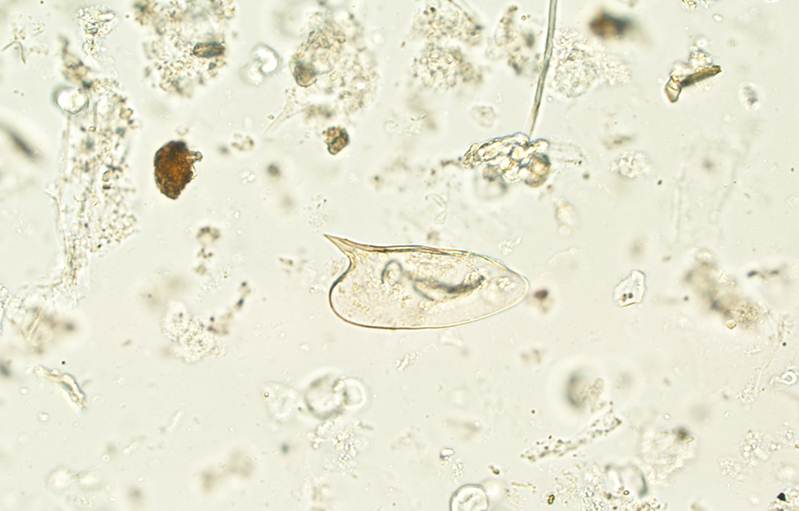
Schistosoma mansoni egg as it might be visualized on stool ova and parasite examination (note the spine on the side). Photo courtesy of Bobbi Pritt, M.D.
Global Burden of Parasitic Infections
A parasite is any organism that lives in, or on, a host and derives its food from, or at the expense of that host. Parasites are among the most common infections that affect humans, although only a minority of parasites actually cause disease. Common pathogenic parasites are generally divided into protozoal infections (e.g. Entamoeba, Giardia, Leishmaniasis, Plasmodium, Cryptosporidium), helminthic infections (e.g. intestinal roundworms, tapeworms, and flukes such as Schistosoma) and ectoparasites (e.g. scabies, lice).
Parasites are ubiquitous worldwide, but they are particularly common in the tropics and sub-tropics. Certain populations are more likely to have parasitic infections, such as those with lower socioeconomic status (SES). The Neglected Tropical Diseases (NTD) as defined by WHO consist largely of parasitic diseases that affect lower SES, disenfranchised, and vulnerable populations. NTD take a tremendous toll in terms of human morbidity and mortality. Public health aims to decrease the global burden of these diseases through programs such as mass presumptive treatment, which is considered one of the most cost-effective health interventions.
Of all the parasitic infections, malaria causes the most deaths annually while soil-transmitted helminths are among the most common.
Refugees and Parasites
Parasitic infections were one of the most frequently encountered medical conditions in newly arrived refugees. During the 1980s and 1990s, the most common parasitic infections found in refugees were soil-transmitted helminthes, Ascaris, Trichuris and hookworm. Beginning in 1999, refugees resettling in the U.S. underwent wide-scale presumptive pre-departure treatment with single-dose albendazole. This treatment has proven to be very effective and cost modeling shows potential for dramatic cost savings [1,2,3]. More recently, refugee morbidity and mortality have been attributed to common chronic parasites (i.e. Strongyloides, Schistosoma spp). These chronic parasitic infections are sometimes found years after arrival and are not adequately treated by the single-dose albendazole [1,4-9].
Learn More:
Contributed by William Stauffer M.D., M.S.P.H., University of Minnesota
References
1. Swanson SJ, Phares CR, Mamo B, et al. Albendazole therapy and enteric parasites in United States-bound refugees. N Engl J Med 2012;366;1498-507.
2. Geltman PL, Cochran J, Hedgecock C. Intestinal parasites among African refugees resettled in Massachusetts and the impact of an overseas pre-departure treatment program. Am J Trop Med Hyg. 2003;69:657-662.
3. Muennig P, Pallin D, Sell RL, Chan MS. The cost effectiveness of strategies for the treatment of intestinal parasites in immigrants. N Engl J Med. 1999;340:773-9.
4. Posey DL, Blackburn BG, Weinberg M, Flagg EW, Ortega L, Wilson M, et al. High prevalence and presumptive treatment of schistosomiasis and strongyloides among African refugees. Clin Infect Dis. 2007;45(10):1210-5.
5. Caruana SR, Kelly HA, Ngeow JY, Ryan NJ, Bennett CM, Chea L, et al. Undiagnosed and potentially lethal parasite infections among immigrants and refugees in Australia. J Travel Med. 2006;13:233-239.
6. Boulware DR, Stauffer WM, Hendel-Paterson BR, Rocha J, Chee-Seong Seet R,Andrea P. Summer AP, et al. Maltreatment of strongyloides infection: case series and worldwide physician–in-training survey. Am J Med. 2007;120(60):545;e1-8.
7. de Silva S, Saykao P, Kelly H, et al. Chronic Strongyloides stercoralis infection in Laotian immigrants and refugees 7-20 years after resettlement in Australia. Epidemiol Infect 2002:128(3):439-44.
8. Lim S, Katz K, Krajden S, Fuksa M, Keystone JS, Kain KC. Complicated and fatal Strongyloides infection in Canadians: risk factors, diagnosis and management. CMAJ. 2004:171:479-84.
9. Newberry AM, Williams DN, Stauffer WM, Boulware DR, Hendel-Paterson BR, Walker PF. Strongyloides hyperinfection presenting as acute respiratory failure and gram-negative sepsis. Chest. 2005;128(5):3681-4.
